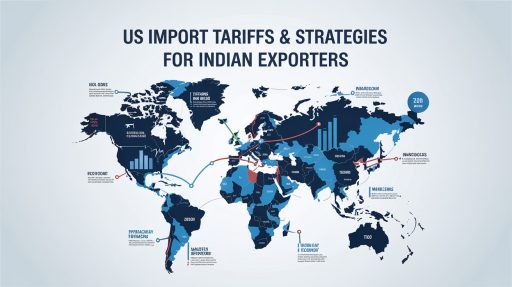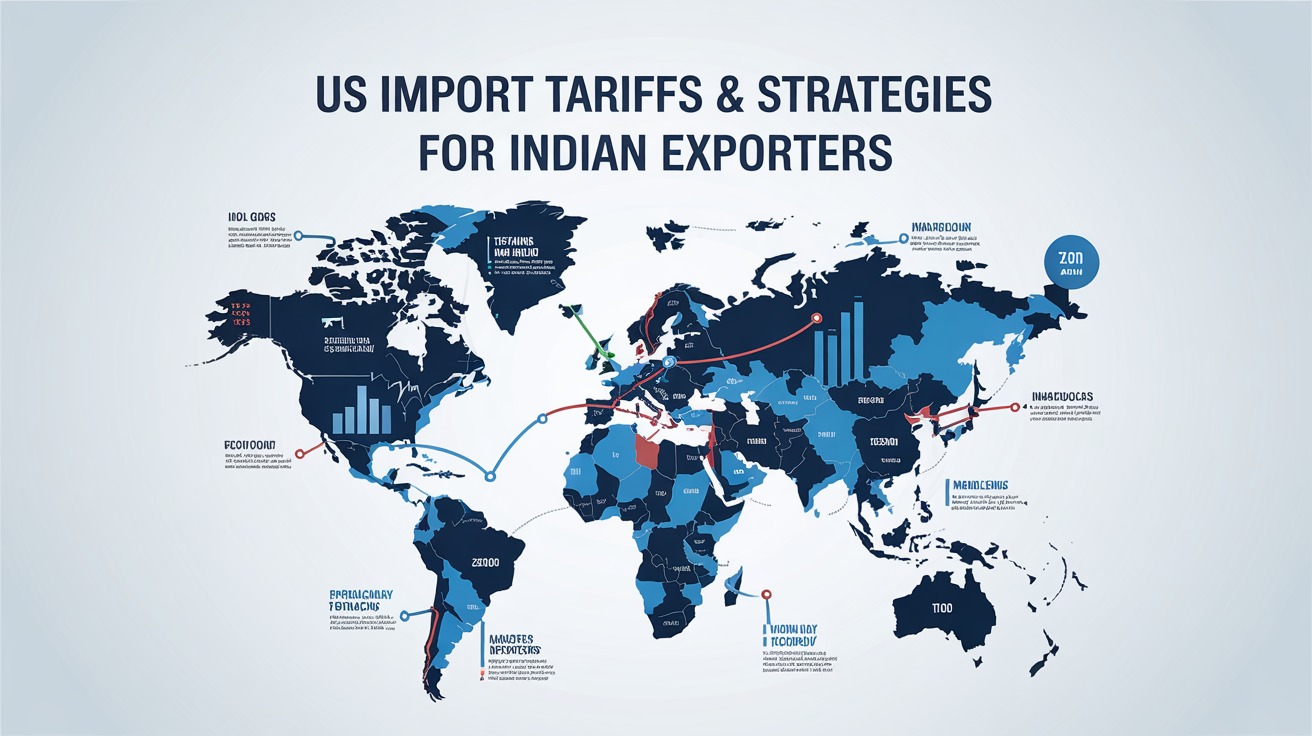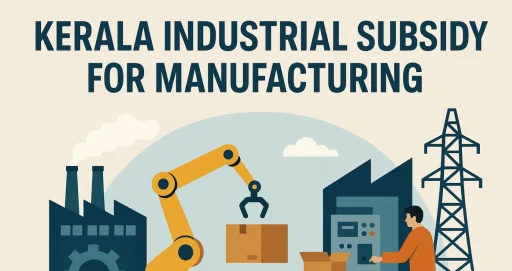The United States, under a renewed approach to trade policy, has recently been ramping up import US tariff on a variety of major sectors. While such tariffs aim mainly at China, the worldwide effects are felt now in places like India. The recalibration comes at a time of geopolitical upheaval, pandemic-induced supply chain breaks, and shifting pathways of global trade routes.
India, an important and emerging economy of the world and a strategic partner for the U.S., is standing at the crossroads. The land may have tough times ahead, but also some opportunities. Thus, India is now faced with the implications of an increase in U.S. import tariffs. This article attempts to present a structured analysis of the impact of the US tariff regime on India, the routes available for exporters in India, and how the Indian government can respond politically and economically to the situation for the best advantage.
Understanding the U.S. Tariff Hikes
Historical Context
The United States has had long-standing use of tariffs as an instrument of economic and political pressure. Notably, in the trade war against China that started in 2018, heavy tariffs were levied against Chinese imports on electronics, machinery, and consumer goods. The Biden administration continued this line of tariff pressure but changed the suit to chmoden-eight and even raised tariffs on semiconductors, critical minerals, batteries, and medical goods.
Among such key sectors are:
- Electronics and semiconductors
- Electric cars and batteries
- Pharmaceutical ingredients
- Steel and aluminum products
- Medical devices and equipment
- Textiles and apparel
Targeted tariffs in these sectors would only seek to reduce China’s market control, thereby giving other exporting nations like India an opportunity to reassess its competitive position and supply chain integration.
Implications for Global Trade Dynamics
Diversification of Supply Chains
One of the most immediate impacts of the increased tariffs on imports into the U.S. from China is the diversification of supply chains. U.S. companies are now attempting to reduce dependence on Chinese suppliers. This is giving rise to the “China + 1” strategy whereby global manufacturers are looking for additional manufacturing bases beyond China. The front-runners in that race happen to be India, Vietnam, Mexico, and Indonesia.
Rise in Manufacturing Relocation
Multinational corporations are either reshoring to the U.S. or offshoring to favorable labor-cost countries with stable governments and good infrastructure. This is a golden opportunity for India to become an FDI destination for the manufacturing sector, especially in electronics, chemicals, pharmaceuticals, and auto parts.
Price Competitiveness and Trade Volume Shifts
A higher tariff on Chinese products increases the price competitiveness of Indian goods in the U.S. This is likely to affect volumes on Indian goods in terms of exports, given the condition that Indian exporters respond accordingly in quality and delivery.
Impact on India-U.S. Trade Relationship
Trade Volume Analysis
Currently, India ranks ninth as a US trading partner which nearly amounts to bilateral trade of $192 billion as of 2023. The US was also the largest export market for India, accounting for over 17% of its total exports.
Strategic Opportunities
- IT Services and Software: This is already the stronghold for India and presents a great opportunity for more collaboration across projects with U.S. tech firms, which would like to reduce dependency on Chinese developers.
- Pharmaceuticals: “Pharmacy of the world”; Indian firms can look to fill in the void, as imports of Chinese APIs and medical supplies have tariffs on them.
- Textiles and Apparel: Garment space, which is strong in India, will likely see an increase in activity due to greater cost advantage than China.
Possible Points of Friction
- Visa and Immigration Policies: This is an agenda on which India will need to fight for better mobility for skilled professionals.
- Digital Trade Regulations: Data flows are supposed to be open for the U.S., while India is in favor of data localization; and this could prove as an obstacle in negotiations.
- Tariff Reciprocity: U.S. has in the past classified India as a non GSP country. Restoration of GSP privileges may give points in negotiations.
Key Considerations for India-U.S. Bilateral Trade Agreement
Such an agreement can put the relationship in proper form and expand the trade between the two countries. Consideration must be given to a few issues:
1. Tariff Reduction Commitments
Both must pursue concessions-from India on high duty imports by the U.S. , and the opening up for selected U.S. goods.
2. Non-Tariff Barriers
Ntb as in customs procedures, technical and sanitary standards, among others should be addressed to facilitate smooth trade.
3. Services and Investment
India must involve itself in negotiating ease of restrictions on investment by the U.S. in sectors like insurance, retail and manufacturing.
4. Digital Trade and E-commerce
An agreeable mechanism for data flows, cyber security and digital taxation is what is needed to avoid future misunderstandings.
5. Environmental and labor Standards
Standards would then be required to meet world ones under trade measures. Therefore, India must proactively get its labor law aligned with modern realities and its environmental guidelines aligning itself more with what the U.S. expects.
Strategies for Indian Exporters
- Product Diversification
Exporters need to target new products under U.S. market demand in emerging fields such as EV components, renewable energy technologies, and specialty chemicals.
2. Quality compliance and certification
Critical mass of such standards as FDA, ANSI, and ASTM according to U.S. standards should be met. Indian firms will need to invest a bundle on product testing, quality audits, and international certifications.
3. Utilize Free Trade Agreements (FTAs)
His country will find a solution to triangulated trade access routes-having FTAs with ASEAN, UAE and other countries-in an indirect method to enter the U.S. market at much lower tariff costs.
4.. Partnership with U.S. Distributors and Buyers
Joint ventures or long-term supply contracts about U.S. companies reduce barriers to entry into markets, while ensuring steady income.
Utilize Government Support Schemes
Systems like RoDTEP, PLI, SEIS, and MEIS can aid in bringing down production costs and improving export margins.
Invest in Branding and Marketing
Indian products are poor in brand recognition. From digital marketing to trade exhibitions to localized packaging, all need to be done for improved perceptions in brand value.
Case Studies of Indian Exporters Gaining from Tariff Revisions
- Tata Chemicals (Specialty Chemicals Export)
Due to the recent imposition of tariffs on specific chemicals imported from China, Tata Chemicals has forged supply partnerships with American firms that are seeking alternatives from China in order to penetrate the U.S. market. It was all possible because of low operational costs in India, quality certifications, and logistics network.
2. Sun Pharma (Pharmaceuticals)
The surge in API and formulation exports to the U.S. from Sun Pharma was primarily triggered by shortages in supply from China. As a result, investments in manufacturing facilities in India that are compliant with the U.S.-FDA were sufficient for the company to ramp up its activities towards closure of the gap.
3. Welspun India (Textiles)
As the U.S. imposed restrictions on textile imports from China’s Xinjiang region, Welspun India was able to enhance its exports of cotton-based home textiles with the support of its vertical integration.
Sector-Wise Opportunity Analysis for Indian Exporters
- Automotive Components
It provides Indian auto part manufacturers, like Bharat Forge and Motherson Sumi, in particular, a great opportunity to start exporting components and parts for EVs as U.S. firms are diversifying their sourcing.
2. Electronics Manufacturing
Under the PLI scheme, companies such as Dixon Technologies can now benefit from their moving into mass production of LED TVs, smartphones, and IT hardware in the U.S. market.
3. Renewable Energy Equipment
Indian manufacturers of solar panels, parts used in wind turbines, and lithium battery components are all emerging strong contenders globally, as there is renewed focus on decarbonization across the globe.
4. Agro and Food Processing
Organic spices, frozen fruits, ready-to-eat meals, and specialty teas all register rapid gains among those American consumers who want clean label traceable products.
Expert Perspectives and Future Outlook
In the words of Dr. Arvind Panagariya, former Vice Chairman of NITI Aayog, trade economists: “India must learn from the shifting global tariff framework that this is to be seen as an opportunity and not as a threat. Indulgence in quick reforms, smart diplomacy, and ease of doing business, can make India a winner.”
“We’re seeing a 30% rise in inquiries from U.S. importers for goods and electronics from India,” says Ms. Priya Seth, Director of Export Promotion Council for E-commerce. At such times, exporters should ramp up digital presence and certifications.
Conclusion
The recent hike in U.S. tariffs is not just a matter of protectionism but a sign of global trade dependency restructuring underway. In India, this marks an inflection point. It is at this point that India should work to align government policies, sign trade agreements, and assist Indian exporters with infrastructure. Financial support to take full advantage of the opportunity set forth by this tariff rise.
Exporters must innovate, comply, and put together global branding. The government, in the meantime, must build some serious bridges of diplomacy. Unwind some constraints on internal trade facilitation mechanisms. If efficiently put into action, this could be multiple chapters of grand perspective in India’s ascent as a manufacturing and export hub internationally.
India has the talent, the intention, and the timing on its side. What now would remain is the strategic orchestration of its strengths to make a position for itself not only as an alternative to China but as an economic powerhouse in its own right.
Note: If you have any questions related to opening any manufacturing business , contact us Niir.org
Read related blogs: Npcs blog







